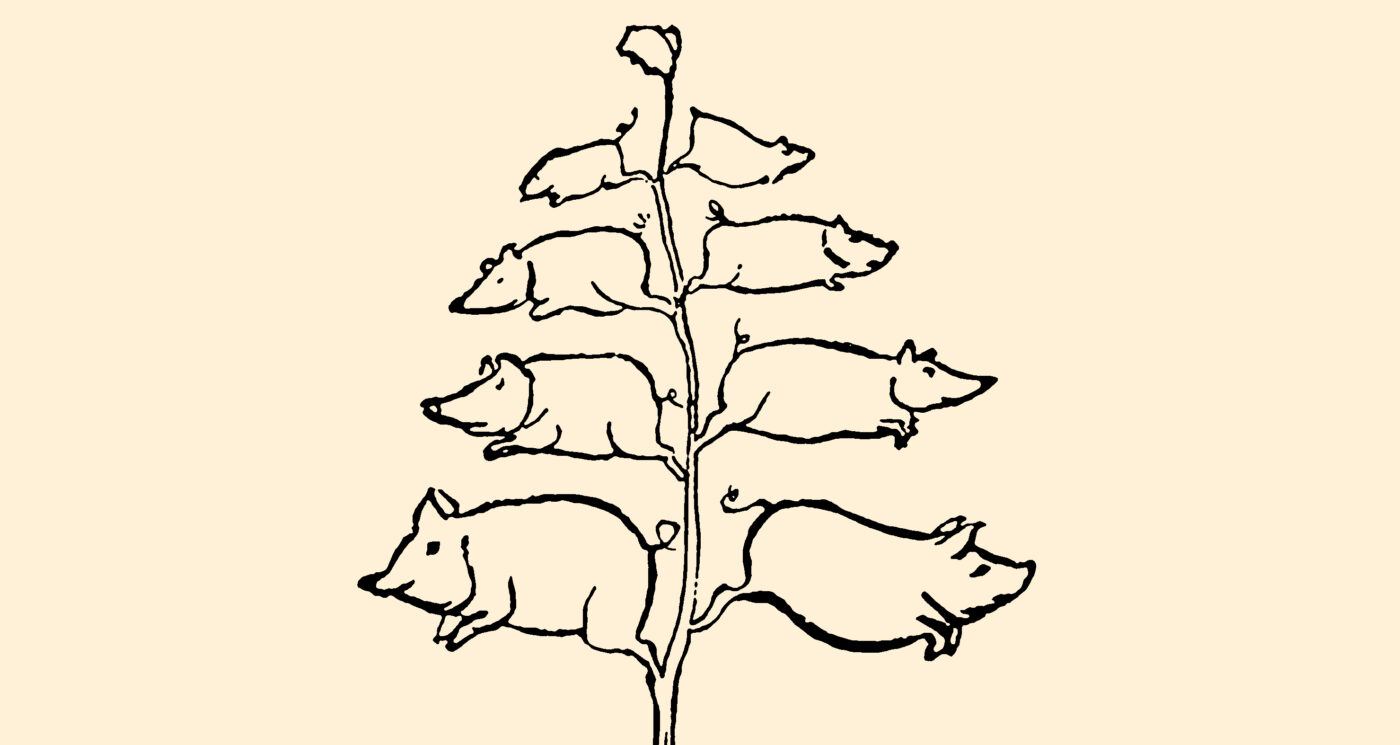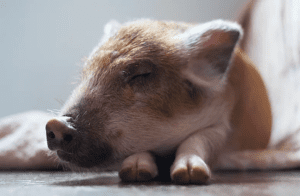

I’ve heard it said that every phase of American capitalism finds its reflection in zombies: if the stumbling undead in George Romero’s Night of the Living Dead evinced the mindless consumerism of the Cold War years, the infected army chasing Brad Pitt in World War Z reveals fear of a contagious, out-of-control globalization, one that Henry A. Giroux has fittingly called “zombie capitalism.” Yet zombies appeared to exit the realm of fiction when word broke in April 2019 that scientists had reanimated pig brains in a small New Haven laboratory. What sort of capitalism births such strange creatures as these?
No single experiment could be a cipher for an entire economic system, but Yale’s “reanimated hogs” were nevertheless symptomatic of broad transformations in the relationship between markets and nonhuman life. After the findings appeared in Nature, the news rocketed across scientific and popular publications, giving new energy to abiding and weighty questions about what separates the living from the dead—and what, exactly, it means to die. If Sus scrofa domesticus brains could return to cellular activity four hours post-mortem, bioethicists wondered, is it time to revise our understanding of mortality?
The pig brains had hardly vanished from our terminally short news cycles before word came last May of a massive African swine fever epidemic in China that threatened the pork supply of the world’s largest producer. Li Xirong, director of the China Animal Agriculture Association, labeled it a “national crisis” that has since doubled the price of pork in China and could continue to impact costs for decades to come. Estimates suggest that half of China’s 440 million pigs were lost last year—nearly a quarter of the world’s total pork supply—and the number could reach at least 300 million. Imagining the sudden disappearance of every person in America, nearly 330 million people, puts the totals in stark perspective.
The African swine fever crisis is not the first time China’s dying pigs have appeared in the news: in 2013, 16,000 pig carcasses floated down the Huangpu River, threatening Shanghai’s drinking water. A fisherwoman joked bitterly that there were now more pigs than fish in the river. The incident symbolized a kind of return of the repressed for a dangerously large industrial pork system that produces 54 million metric tons of pork (out of 100 million worldwide). First as farce, then as tragedy.
When the origin of Covid-19 was traced to Wuhan’s wet markets (although to bats and perhaps pangolins, not pigs), arguments about the country’s out-of-control breeding and consumption of meat were trotted out once more. According to PETA, the coronavirus outbreak was clear proof of the necessity of eliminating animals as food. Yet as many pointed out in response, the problem of eating animals (even wild ones, a decades- or centuries-old practice) may be less significant than the way exploding industrial production of pork has pushed farmers into closer contact with new biological niches and unknown viral complexes. One accidental effect of the latest viral crisis may be decreased meat consumption in the world’s prime meat hub.
The variously literal and metaphorical porcine zombies share a connection to a massive global industry that has simultaneously made pork one of the most widely consumed meats and pigs the default test subjects for many of biology’s most challenging questions: reanimated brains, replaced organs, and the cure for Alzheimer’s are just a few. To understand how meat and science have become so intertwined, and why it matters, we need to turn back to a time when factories were still finding their footing and hogs were just entering the halls of experiment.
In high school science classrooms all across the United States, aspiring biologists and their peers learn about the human body by dissecting fetal pigs. Cutting delicately across their bodies, queasy students are trained to recognize the appearance of anatomical features that often mirror our own. Despite presumptive species differences, it turns out that human and pig bodies share a great deal of similarity. Indeed, these dissectors are enrolled, often without conscious awareness, in a millennia-spanning endeavor that traces back to the earliest published anatomical textbooks, including Salerno’s Anatomia porci, from the 11th and 12th centuries, which taught anatomy through the dissection of hogs.
In an otherwise forgettable episode of the X-Files (S2E14, “Die Hand Die Verletzt”), a traumatized teenager finds her pig coming back to life during a make-up dissection lab. The shock value, to the extent that the clunky special effects still offer one, arises from one unspoken requirement of dissection: not only that the specimen is dead (of course), but that it must seem to have never lived. The fetal pig, arriving in shrink-wrapped plastic, is an inert object with no meaningful point of origin, more product than being.
This is little more than a marketing strategy. Despite historical precedents, modern fetal pig dissection is an early twentieth century phenomenon that coincided with a rapid expansion of American pork packing. Once, when the “kill cycle” of hogs was slower, sows were allowed to carry pregnancies to term. But with the ever-increasing speed and intensity of pork rendering, which helped make metropolises out of Cincinnati and Chicago, waiting for births was simply an inefficiency. Because fetal pigs don’t make for much in the way of eating, unborn swine were typically tossed away or, at best, converted to fertilizer while their mothers became meat. Until the professors came along, that is.
When William J. Baumgartner published his Laboratory Manual of the Foetal Pig, one of the first texts dedicated to the subject, in 1924, he extolled the “unlimited number of specimens” available “at any good-sized packing plant.” In a review, Henry Higgins Lane, the former director of Kansas University’s History Museum, praised Baumgartner for bringing attention to “a form hitherto largely over-looked” in classroom dissection. Overlooked, but greatly valuable: enterprising young Midwestern professors could take a quick trip to the local rendering plant and buy a classroom supply of fetal pigs without breaking the budget. The unceasingly efficient pork production system that used “everything about the hog except the squeal,” in the words of Upton Sinclair’s The Jungle, was the sine qua non for this discovery.
In the industry, fetal pigs are considered “by-products” of pork production, but that terminology obfuscates the truth that they are neither inevitable by-products nor chance accidents. Fetal pigs are not allowed a birth in the first place, because a system premised on maximizing meat cannot afford the delay. And while they initially seemed like little more than a useful piece of good fortune for educational institutions, the little swine could not escape further capitalization. “Capital sees waste as the final frontier for commodification,” writes scholar Todd McGowan, and the nascent laboratory supply industry cornered the market as mass suppliers of high-quality classroom “specimens” by the mid-twentieth century.
That transformation was part of a broader reconfiguration of the relationship between science educators and their classroom materials. Late-nineteenth-century dissection manuals are overflowing with grisly tales of cats chloroformed in homemade boxes. Once pigs became purchased products, professors increasingly ordered, rather than scavenged, their classroom specimens. More than inert nature, teaching specimens became commodities, with entrepreneurial academics often founding supply companies of their own. The “accident” of fetal pig dissection was a foundational moment in the increasingly intricate intersection of pig science with pork production.
While Big Pork pushed fetal pigs onto classroom tables, one specific pork product—Spam—was central to the next important development in porcine science: the experimental minipig. The connection should come as no surprise: where science and hogs meet, the question of edibility is never far off.
George A. Hormel, a former Chicago slaughterhouse employee, took out a small loan to open his own meat production company in Austin, Minnesota in 1891. There he introduced the first mass market canned ham product, Hormel Flavor-Sealed Ham, and then the better-known Spam, which debuted in 1937 and helped feed American soldiers overseas. In 1942, George’s son Jay used the family fortune to convert old horse stables into a high-tech (for the time) space of experimentation in agricultural science and medicine. Jay’s newly formed Hormel Institute joined forces with the nearby Mayo Clinic and the National Heart Institute in 1949 to develop a “miniature swine” that could serve in biomedical research.
Although they were not meant for eating, miniature swine represented an effective reversal of the typical strategy of agricultural breeders like Hormel. Many involved in the miniature pig project had previously worked to breed the “Minnesota No. 1” and “No. 2” pigs, meat-heavy hogs that promised increased returns on farm investments. The No. 1 and No. 2 were early exemplars of the application of genetic techniques to industrial agriculture, and the lessons they offered were crucial to breeding a consistently small hog that was still “normal” enough to produce uniform scientific results. Though widespread now, the idea of breeding pigs for something other than dinner was so novel that a Newsweek article on the miniature swine in 1953 had to clarify that they were not meant to provide Americans “with Tom Thumb pork chops,” but rather “to help medical researchers battle against cancer, diabetes, virus diseases, and other human maladies.”

Though many researchers preferred dogs and rodents for experimental studies, miniature pigs gradually gained popularity. They served as nuclear test detectors, since pigs’ skin reacted similarly to that of humans. They were given new hearts to study the feasibility of different allotransplant techniques before human-to-human transplantation became commonplace. They were even fed extreme diets to study obesity and atherosclerosis under the theory that domestication made them “a counterpart, even a caricature, of the overfed, physically lethargic human population.” In a 1966 article in Scientific American, longtime hog evangelist Leo K. Bustad proclaimed that pigs were “In almost every way … a closer analogy to man than those laboratory favorites, the rat and the dog.”
Yet comparable claims of similarity could be made—and were—for dogs, sheep, goats, horses, and a great many other species besides. Using pigs was partly a matter of personal or laboratory style; not so coincidentally, many institutions that adopted this style were located in or near major agricultural centers. And while “experimental” pigs were promised different futures than their table-bound kin, both would fall prey to the same developments in veterinary and agricultural knowledge. Initially a spinoff of industrial production, like fetal pigs, miniature swine generated new synergies between agriculture and basic science: laboratory studies produced improvements in pork production and vice versa.
Despite the hype from Bustad and others, many researchers were content with rodents or dogs, and hesitant to switch over to the pig. The typical farm hog is around 215 pounds; at 170 pounds, the first minipigs were more manageable but still challenging to feed and control. Even today, despite decades of careful miniaturization (trademarked Ellegaard Göttingen “minipigs” weigh around 60 pounds), scientific minipigs remain boutique research subjects. What was lacking, then and now, were economies of scale that could match the seemingly infinite production of laboratory mice and rats (17-22 million are used annually in the US alone, according to estimates). But supporters of experimental pigs, whether minipigs for toxicology studies or larger farm hogs for dietary studies, have continued to defend a future for pigs in the lab.
One unnerving version of that future appears in Margaret Atwood’s post-apocalyptic gem Oryx and Crake (2004). In the novel, a biotech-dominated community promises its residents extended life through an unlimited supply of transplantable organs from “pigoons,” transgenic pigs holding multiple “humanized” kidneys. Fourteen years after Oryx and Crake, a New York Times Magazine piece proposed that genetically engineered pigs could make the “donor-organ shortage… a thing of the past.” As one Vox article put it, “It’s Margaret Atwood’s dystopian future, and we’re just living in it.”
Atwood, however, did not invent pigoons out of whole cloth. Instead, the dream of exchanging organs between species (xeno– as compared with conventional allo-transplantation) has been vigorously pursued since the early 1990s. As transplant pioneer Thomas Starzl and colleagues opened their 1997 article, “The Future of Transplantation”: “Further real growth of transplantation will depend on the use of animal organs.” With limited donations but ever-escalating demand for organs, alternatives appeared necessary. But those dreams have stumbled on a dauntless procession of scientific obstacles, with graft rejection (when the body fights off a new organ as alien) and potentially zoonotic diseases (those that transfer between species) at the top of the list. Many in the field, and others who left for greener pastures, joke that “xenotransplantation is the future of transplantation and always will be.”
While early xenotransplantation research focused on nonhuman primates as principal donors, pigs—“Frankenswine,” in scientist David K. C. Cooper’s words—have become the dominant subject of study today. On the one hand, the prohibitively high costs and ethical misgivings associated with nonhuman primates pushed researchers toward alternatives. But even more significantly, primates are typically slow and scant breeders. Larger pigs with human-sized organs, on the other hand, could be raised cheaply and economically in large numbers.
Organ transplantation has always maintained a strange semiotic connection with agriculture: organs are “harvested” from donors. But visions of porcine xenotransplantation made what was metaphorical both literal and explicit. Pigs involved in contemporary research are raised at small “experimental farms” that scientists dream of expanding into massive, hulking industrial organ production facilities with transnational distribution capacities. Researchers David K. C. Cooper and Robert Lanza’s Xeno: The Promise of Transplanting Animal Organs into Humans (2000), for instance, opens with a piece of science fiction imagining exactly that. In both instances, the pastoral and industrial architecture of contemporary agriculture is repurposed for scientific uses. Where the collectors of fetal pigs once made do with the scraps of industrial overproduction, today’s xenoplantation researchers are devising a whole new industry in which they would serve first as biomedical farmers and then industrial organ packers.
For good reason, many question not only the technical feasibility of this quest, but also its ramifications. Xenotransplantation researchers have carried out numerous studies on whether pig organ recipients would feel “human” if they knew their heart was not, and/or whether their families would treat them any differently. This fear finds its reflection in fiction: In Yann Martel’s short story, “We Ate the Children Last,” pig heart xenografts transform their human recipients into violent, insatiably hungry monsters. Psychological consequences aside, engineering animals with genetically identical, “humanized” organs only to slaughter them later seems, at best, morally complex.
Yet when PBS Frontline asked David H. Sachs, the former director of Mass General Hospital’s xenotransplantation project, how he conceptualized the ethics of his work, his answer was revealing: “[O]ur societies have determined that it’s all right to use pigs as a source of food. And it’s hard for me to understand how it would be unreasonable to use a heart from a pig, for example, to save someone’s life, if it’s all right to use the pigs to produce bacon and pork sausages.” The future of xenotransplantation, in other words, is a carnivorous one, with the edibility of pigs justifying their utility as living organ banks. Vegetarians, vegans, and the potential displacement of pork’s cultural centrality are, in the view of many researchers, irrelevant to the social good that pig organs might bring. If hogs are destined for the plate, they might as well give their organs in other ways, too.
Although xenotransplantation may be an extreme example (one liable to oscillating dystopian and utopian imaginaries), many of today’s more quotidian sciences have also seized upon the presumed inevitability of pork production to justify research. In 2010, Emøke Bendixen and colleagues at Åarhus University extolled the virtues of pigs for molecular biomedical research by noting that “the agricultural industry produces 1 billion pigs every year globally,” which “represents a valuable resource from which experimental animals can be selected.” The local production numbers of earlier eras give way to new possibilities opened up by global markets. In a proposal to use pigs as models for infectious disease spread, François Meurens and colleagues list the first key “advantage” of the porcine model as “Availability (most important meat-producing livestock species worldwide).”
What if that status changed? The question is swept aside in scientific publications, suggesting just how much culinary and agricultural assumptions have penetrated experimental commonsense. When, in an eerie echo of the floating Huangpu pigs, criminologists Gail S. Anderson and Lynne S. Bell “deployed” three hog carcasses to a small Canadian inlet in 2013 in order to investigate the process of bodily decomposition in water, they relied on the broader system of pork production. The pigs—initially intended for consumption—“were euthanized with a humane pin-gun or by electrocution by a licenced butcher and were received after death.”
It often seems, in scientific publications, that the sheer monumentality of pork production itself demands alternative uses for pigs. From fetal pig dissections to organ farms, scientists have been more than happy to assist by upcycling extra hogs or industrial pork’s by-products. Research by anthropologist Mette Nordahl Svendsen into the links between Danish pork production and infant nutrition offers one example that unites many threads from the story thus far. As Svendsen tells it, scientific agricultural breeding over several decades has produced Danish pigs that bear increasingly large litters. This is valuable from a meat perspective but also means that sows can no longer produce enough milk for their piglets. Researchers realized that Bovine colostrum, a by-product from the dairy industry, might serve as a dietary supplement and began feeding it to piglets. Scientists studying neonatal care in humans recognized that the piglets taking colostrum might, in turn, be a model for premature human infants receiving colostrum supplements, leading to experimental tests in neonatal care units. Here human children and piglets are united and analogized by a nexus of biological and agricultural study that draws together hospitals, laboratories, and farms.
It can be tempting to view these results as unquestionable successes, evidence that industrial pork produces a constant stream of social good by way of scientific research. These by-products, however, must be considered in context with the other externalities of breeding millions of tons of hogs every year. In 2018, Hurricane Florence revealed the risks of open-air “poop lagoons,” large pits of hog feces near major pork production facilities. The lagoons are typically used to generate nutrient-rich fertilizer, but excess rainwater threatened to send acrid biomatter into the waterways serving many rural communities and pollute their drinking water. Then there are the disastrous contributions to climate change from the meat industry more broadly, arguably the single largest contributor of greenhouse gases when cows are added to the equation. What if poop lagoons and destructive global consumption habits are the price we pay for biomedical progress?
The Yale researchers who reanimated pig brains in 2019 explained that their research did not involve the killing of any actual pigs, but “used brain tissue retrieved after death from pigs used for food production.” Though around 300 pig brains from USDA-approved food production facilities were used in the research, the authors assure readers: “No animals died for this study.” Research is positioned as an act of salvaging waste; the killing happens elsewhere. The pig brain tissue was left over, and some good ought to come of it. This was Baumgartner’s logic exactly, and it is an explanation that may allow scientists to avoid stringent animal testing regulations.
The problem, however, is that animals did die for this study, in much the same way that they died for the host of other scientific projects that have enrolled hogs in the last half-century. The notion that the realm of “science” and the factory killing floor are neatly separated is belied by the countless researchers who have explicitly described the value of industrial production for experimentation. Science remains tied to industry, now as in the past. Science remains carnivorous, yet claims, like an uneasy meat-eater, that it does not kill the animals itself. Ultimately, such arguments are a disavowal of responsibility for the role research institutions play in sustaining demand for these “by-products.”
Rather than standing afar and benefitting only accidentally from the cheap, dead matter cast off by a distant system of meat generation, scientists are accountable for that system’s propagation. Laboratories may return life to the dead, but they play a part in the killing as well, even as centuries of experimentalists have euphemized such actions with the term “sacrifice.” To “sacrifice” a laboratory animal suggests that the cause was just; to “kill” implicates one in a much more complicated moral deliberation. Whether pigs become food or food for thought, their edibility remains central. Both uses continue to justify the limitless creation of carcasses from the world’s rendering plants—a trend which is far from sustainable.
Climate scientists estimate that the world’s citizens may need to eat up to 90% less pork in order to avert the most catastrophic effects of global warming. Such a decline in consumption would be an existential threat to the pork industry as it is currently structured. But even if the dietary revolution is slow to arrive, pork production will inevitably adapt to the climate crisis. A hotter planet will likely bring skinnier pigs as heat reduces protein storage and sows’ fertility, raising costs significantly. (That change might be greeted with a small sigh of relief from the industry: one recent article was titled, “The U.S. Has So Many Fat Pigs That Pork Prices Are at Decade Low.”)
Skinnier pigs will generate more incentive to extract further gains in efficiency—more pigs crammed more tightly together giving birth to more piglets. The challenge, however, is that overcrowded sties and the race to generate more meat has been directly linked with repeated disease outbreaks. The swine fever epidemic in China will not likely be the last, nor the largest, particularly if the industry’s response is to push forward with only slightly more surveillance or minor safeguards. When pigs floated down the Huangpu in 2013, the response was to castigate a few bad actors for failing to follow livestock laws. Yet within six years, the even larger catastrophe of the flu epidemic showed such precautions to be woefully inadequate. With Chinese cases of Covid-19 decreasing, new reports of sick pigs are rapidly growing.
In any case, scientists who have long leaned on the cheap disposability of industrial hogs may soon find themselves trying to conduct experiments in a radically altered world. Climatic shifts will affect not only the conditions for agriculture, but for science itself. The excuse that animals were not killed for experiments that rely on their dead matter will, as the scale increases, be revealed as obviously inadequate. Behaviors that are “insignificant or even trivial” in individual cases, writes ecocritic Timothy Clark, can at large scales represent “a threat to the integrity of the environment itself.” Such is certainly the case for repurposed hog bodies.
Once pigs are no longer the cheap, inevitable servants of science, new models and novel organisms may be necessary. Alternative visions of interspecies similarity will doubtless emerge to justify their usage. While pigs will remain useful for the viruses that specifically impact their kin, high school classrooms may have to purchase other small creatures preserved in formaldehyde, or eliminate dissection entirely. In another system of social organization, a different arrangement of multispecies life could emerge, one not premised on easy devaluations based in economic utility, but on questions of ecological balance and justice. Without that reorientation, the zombies may arrive just in time to watch the world burn with us.
Brad Bolman is a graduate student in the History of Science at Harvard.



